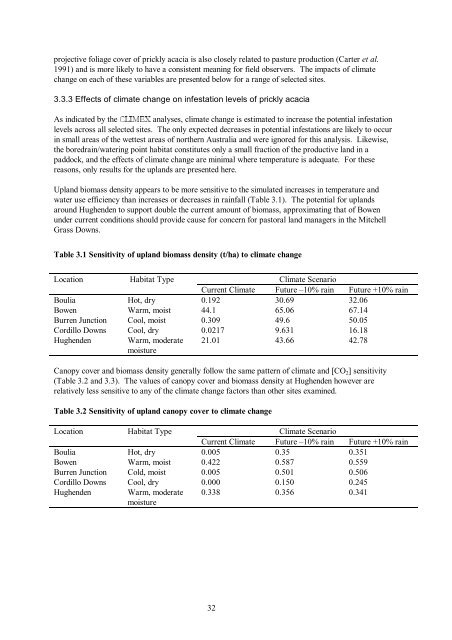EXOTIC WOODY WEEDS Use of simulation models to predict future ...
EXOTIC WOODY WEEDS Use of simulation models to predict future ...
EXOTIC WOODY WEEDS Use of simulation models to predict future ...
Create successful ePaper yourself
Turn your PDF publications into a flip-book with our unique Google optimized e-Paper software.
projective foliage cover <strong>of</strong> prickly acacia is also closely related <strong>to</strong> pasture production (Carter et al.<br />
1991) and is more likely <strong>to</strong> have a consistent meaning for field observers. The impacts <strong>of</strong> climate<br />
change on each <strong>of</strong> these variables are presented below for a range <strong>of</strong> selected sites.<br />
3.3.3 Effects <strong>of</strong> climate change on infestation levels <strong>of</strong> prickly acacia<br />
As indicated by the &/,0(; analyses, climate change is estimated <strong>to</strong> increase the potential infestation<br />
levels across all selected sites. The only expected decreases in potential infestations are likely <strong>to</strong> occur<br />
in small areas <strong>of</strong> the wettest areas <strong>of</strong> northern Australia and were ignored for this analysis. Likewise,<br />
the boredrain/watering point habitat constitutes only a small fraction <strong>of</strong> the productive land in a<br />
paddock, and the effects <strong>of</strong> climate change are minimal where temperature is adequate. For these<br />
reasons, only results for the uplands are presented here.<br />
Upland biomass density appears <strong>to</strong> be more sensitive <strong>to</strong> the simulated increases in temperature and<br />
water use efficiency than increases or decreases in rainfall (Table 3.1). The potential for uplands<br />
around Hughenden <strong>to</strong> support double the current amount <strong>of</strong> biomass, approximating that <strong>of</strong> Bowen<br />
under current conditions should provide cause for concern for pas<strong>to</strong>ral land managers in the Mitchell<br />
Grass Downs.<br />
Table 3.1 Sensitivity <strong>of</strong> upland biomass density (t/ha) <strong>to</strong> climate change<br />
Location<br />
Habitat Type<br />
Climate Scenario<br />
Current Climate Future –10% rain Future +10% rain<br />
Boulia Hot, dry 0.192 30.69 32.06<br />
Bowen Warm, moist 44.1 65.06 67.14<br />
Burren Junction Cool, moist 0.309 49.6 50.05<br />
Cordillo Downs Cool, dry 0.0217 9.631 16.18<br />
Hughenden Warm, moderate<br />
moisture<br />
21.01 43.66 42.78<br />
Canopy cover and biomass density generally follow the same pattern <strong>of</strong> climate and [CO 2 ] sensitivity<br />
(Table 3.2 and 3.3). The values <strong>of</strong> canopy cover and biomass density at Hughenden however are<br />
relatively less sensitive <strong>to</strong> any <strong>of</strong> the climate change fac<strong>to</strong>rs than other sites examined.<br />
Table 3.2 Sensitivity <strong>of</strong> upland canopy cover <strong>to</strong> climate change<br />
Location<br />
Habitat Type<br />
Climate Scenario<br />
Current Climate Future –10% rain Future +10% rain<br />
Boulia Hot, dry 0.005 0.35 0.351<br />
Bowen Warm, moist 0.422 0.587 0.559<br />
Burren Junction Cold, moist 0.005 0.501 0.506<br />
Cordillo Downs Cool, dry 0.000 0.150 0.245<br />
Hughenden Warm, moderate<br />
moisture<br />
0.338 0.356 0.341<br />
32

















